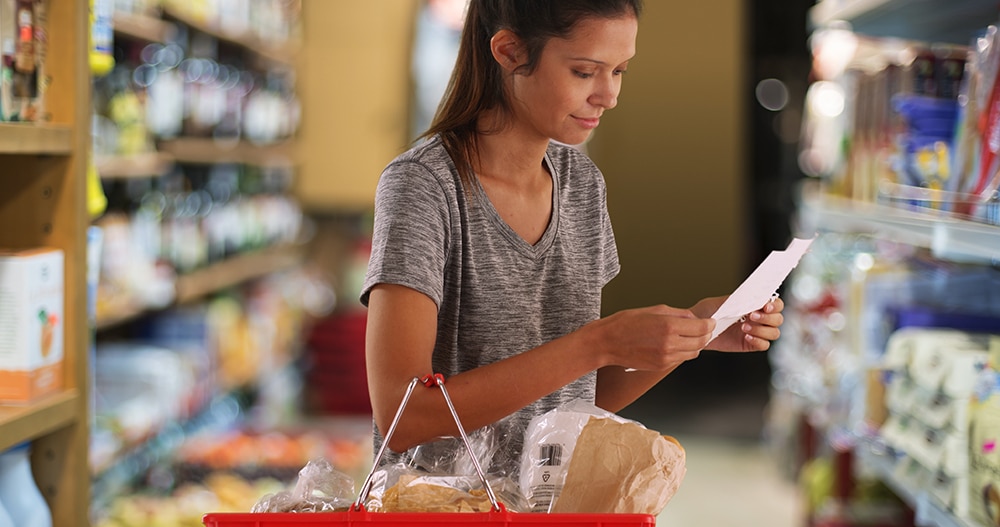A Vegetarian Athlete’s Grocery List

Written by Doug Hay
Grocery shopping is typically one of those tasks that you either view as a chore or a needed escape from the house.
But when shopping to feed a plant-based diet, it can also be an opportunity to explore new foods and inspire creative dishes.
I actually love grocery shopping, and pre-pandemic, I would often go multiple times per week just to get the freshest ingredients for a recipe I was cooking that night.
Was it a good use of time? Maybe not. But it brought me joy.
Still, I probably wouldn’t recommend that type of grocery shopping, especially if you’re new to the plant-based diet. Wandering the aisles for a few feeds can be both frustrating and lead to poor food choices.
Instead, I recommend having a list and a plan.
Below I share two approaches to grocery shopping — mine and Doug’s — and share a basic pantry staples grocery list to get you started. It’s by no means a complete list, but if you have the items in your pantry or fridge, the cooking options are pretty much endless.
2 approaches to grocery shopping
In a recent conversation with Doug, co-host of No Meat Athlete Radio, we realized we have two different approaches to grocery shopping.
The differences here might be subtle, but they’re important enough for me to include both options. Let’s start with mine and I’ll explain more later:
- Matt’s Approach: Go into the store with a complete list and stick to it. Don’t get tempted by random foods you see that might sound good in the moment.
- Doug’s Approach: Shop with a rough list in mind — the essentials you know you’re going to need. Then take inspiration from other food items that stand out (sauces, noodles, veggies, etc.).
My approach requires a bit more planning and often means you’re following specific recipes, but it means you’re rarely wasting any food or get tempted by less-than-healthy items that stand out.
Doug’s approach reflects his approach to cooking, which is less about recipes and more about using what’s in the fridge or pantry. It follows more of the loose guidelines laid out in our posts like his Sauce System or the Chipotle Method.
Both can work really well depending on your preference when it comes to cooking (recipes vs. loose cooking).
But either way, it really helps to have the basics on hand.
The plant-based pantry shopping list
Here’s a basic vegan shopping list. With it, I’ve tried to cover all the general foods a plant-based athlete would need.
If you’re new to the plant-base diet, don’t freak out. There’s a lot of green here and maybe a few other ingredients you don’t typically purchase, and that’s totally fine. Maybe leave some of them off for now and try out just a few new items at a time.
(Note: A few items you obviously don’t buy every trip to the store, but they’re good to keep around for cooking.)
- Fruit: Apples, Oranges, Bananas, Pineapples, Fresh Berries, Mixed Frozen Berries (for smoothies), Lemons, Limes, Tomatoes, Avocados, Madjool Dates (For real fruit workout fuel, check out Plant Bites)
- Fresh Vegetables: Romaine Lettuce, Spinach, Broccoli, Kale, Celery, Cucumbers, Bell Peppers, Jalapeno Peppers, Onions, Carrots, Garlic, Basil, Parsley, Cilantro
- Starchy Vegetables: Potatoes, Sweet Potatoes
- Canned or Dried Fruits/Vegetables: Diced Tomatoes, Raisins,
- Legumes: Lentils, Chickpeas, Black Beans (preferably dry, but sometimes canned)
- Non-Wheat Grains: Brown Rice, Quinoa (not technically a grain), Granola, Spelt Pasta
- Wheat Products (limited): Whole-Wheat Bread, Pasta, Pitas, Bagels, and Wraps
- Breakfast Cereals: Kashi, Steel Cut Oats
- Nuts and Seeds: Almonds, Cashews, Walnuts, Flaxseeds, Chia Seeds
- Spreads and Pastes: Hummus, Nut Butters (almond is great but expensive), Tahini (sesame seed paste), Baba Ganoush
- Oils: Olive Oil, Grapeseed Oil, Toasted Sesame Oil, Flaxseed Oil, Coconut Oil (solid at room temperature, often in the health food aisle)
- Vinegars: Apple Cider Vinegar, Balsamic Vinegar, Red Wine Vinegar
- Protein powder: Real food ingredients (like what we use in Complement Protein)
- Plant Milks: Almond or Coconut are my favorite
- Tea and Coffee
- Soy Products (limited): Tofu, Tempeh, Soy Sauce or Bragg’s Amino Acids
- Other Snacks (limited): Tortilla Chips, Salsa, Popcorn
- Plant-Based Meat (optional): Amy’s Frozen Veggie Burgers, Veggie Meat Slices, Beyond Burgers
- Miscellaneous: Agave Nectar, Dark Chocolate, Miyoko’s butter
- A Supplement: Ideally just the essentials.
What about the junk food?
I’ll leave that up to you. There’s no shame in treating yourself to something special, but I don’t think it belongs on an essentials list like this.
With this list, the options are endless…
If you follow the list above, you can categories everything into one of four categories:
- Fruits, veggies, and greens
- Proteins (nuts, seeds, soy products, and legumes)
- Grains
- Miscellaneous (oils, vinegar, etc.)
As an athlete, focused mostly on my carbohydrate to protein ratios, those first three categories are pretty much where I live.
And with these basics, you can whip up endless plant-based recipes your whole family will love.
Written by Matt Frazier
I’m here with a message that, without a doubt, isn’t going to make me the most popular guy at the vegan potluck.
But it’s one I believe is absolutely critical to the long term health of our movement, and that’s why I’m committed to sharing it. Here goes…
Vegans need more than just B12.
Sure, Vitamin B12 might be the only supplement required by vegans in order to survive. But if you’re anything like me, you’re interested in much more than survival — you want to thrive.
So what else do vegans need?
from WordPress https://ift.tt/33jMOge
via IFTTT
Comments
Post a Comment